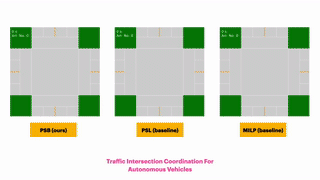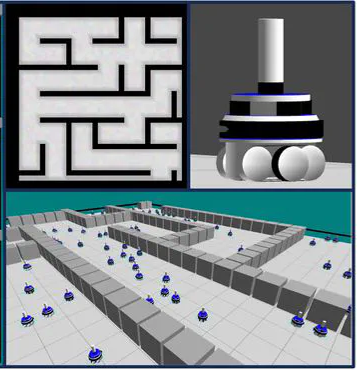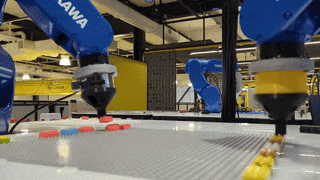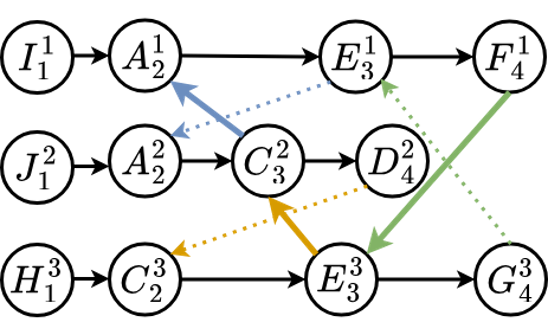From Plan to Reality: Robust Execution for Multi-Robot Systems

Coordinating a large team of robots for navigation tasks in a congested environment, such as automated warehouses, poses a critical challenge. While current Multi-Agent Path Finding (MAPF) solvers show promises by generating paths in seconds for hundreds of agents (simplified versions of robots) and providing important theoretical guarantees such as soundness, completeness, and even optimality, they overlook real-world constraints like robot dynamics and execution uncertainties. So naively executing them synchronously can be very inefficient (see the figure on the right).
Our goal is to bridge this gap by developing a safe and effective multi-robot path planning and execution framework. This framework aims to enable thousands of heterogeneous robots to navigate in the presence of complex obstacles, non-holonomic dynamics, actuation limits, and disturbances while minimizing travel times and communication efforts. We are currently exploring two research lines to achieve this goal: Generating MAPF plans that account for only important robot dynamics and uncertainties and developing execution frameworks to safely execute potentially imperfect MAPF plans.
MAPF Planning with Robot Dynamics

Most MAPF planners can be viewed as hierarchical frameworks, as illustrated in the figure on the right. This perspective allows us to integrate MAPF algorithms with different single-agent motion planners and collision checkers, enabling MAPF to address a broader class of Multi-Agent Motion Planning problems that incorporate robot dynamics. See more details here.
Relevant publications
Multi-agent Motion Planning for Differential Drive Robots Through Stationary State Search.
Abstract BibTeX Publisher arXiv CodeMulti-Agent Motion Planning (MAMP) finds various applications in fields such as traffic management, airport operations, and warehouse automation. In many of these environments, differential drive robots are commonly used. These robots have a kinodynamic model that allows only in-place rotation and movement along their current orientation, subject to speed and acceleration limits. However, existing Multi-Agent Path Finding (MAPF)-based methods often use simplified models for robot kinodynamics, which limits their practicality and realism. In this paper, we introduce a three-level framework called MASS to address these challenges. MASS combines MAPF-based methods with our proposed stationary state search planner to generate high-quality kinodynamically-feasible plans. We further extend MASS using an adaptive window mechanism to address the lifelong MAMP problem. Empirically, we tested our methods on the single-shot grid map domain and the lifelong warehouse domain. Our method shows up to 400% improvements in terms of throughput compared to existing methods.
@inproceedings{ YanAAAI25,
author = "Jingtian Yan and Jiaoyang Li",
title = "Multi-agent Motion Planning for Differential Drive Robots Through Stationary State Search",
booktitle = "Proceedings of the AAAI Conference on Artificial Intelligence (AAAI)",
pages = "23360-23368",
year = "2025",
doi = "10.1609/aaai.v39i22.34503",
}Multi-Agent Motion Planning With Bézier Curve Optimization Under Kinodynamic Constraints.
Abstract BibTeX Publisher arXiv CodeMulti-Agent Motion Planning (MAMP) is a problem that seeks collision-free dynamically-feasible trajectories for multiple moving agents in a known environment while minimizing their travel time. MAMP is closely related to the well-studied Multi-Agent Path-Finding (MAPF) problem. Recently, MAPF methods have achieved great success in finding collision-free paths for a substantial number of agents. However, those methods often overlook the kinodynamic constraints of the agents, assuming instantaneous movement, which limits their practicality and realism. In this paper, we present a three-level MAPF-based planner called PSB to address the challenges posed by MAMP. PSB fully considers the kinodynamic capability of the agents and produces solutions with smooth speed profiles that can be directly executed by the controller. Empirically, we evaluate PSB within the domains of traffic intersection coordination for autonomous vehicles and obstacle-rich grid map navigation for mobile robots. PSB shows up to 49.79% improvements in solution cost compared to existing methods.
@article{ YanRAL24,
author = "Jingtian Yan and Jiaoyang Li",
title = "Multi-Agent Motion Planning With Bézier Curve Optimization Under Kinodynamic Constraints",
journal = "IEEE Robotics and Automation Letters",
volume = "9",
number = "3",
pages = "3021-3028",
year = "2024",
doi = "10.1109/LRA.2024.3363543",
}Multi-Robot Execution and Monitoring
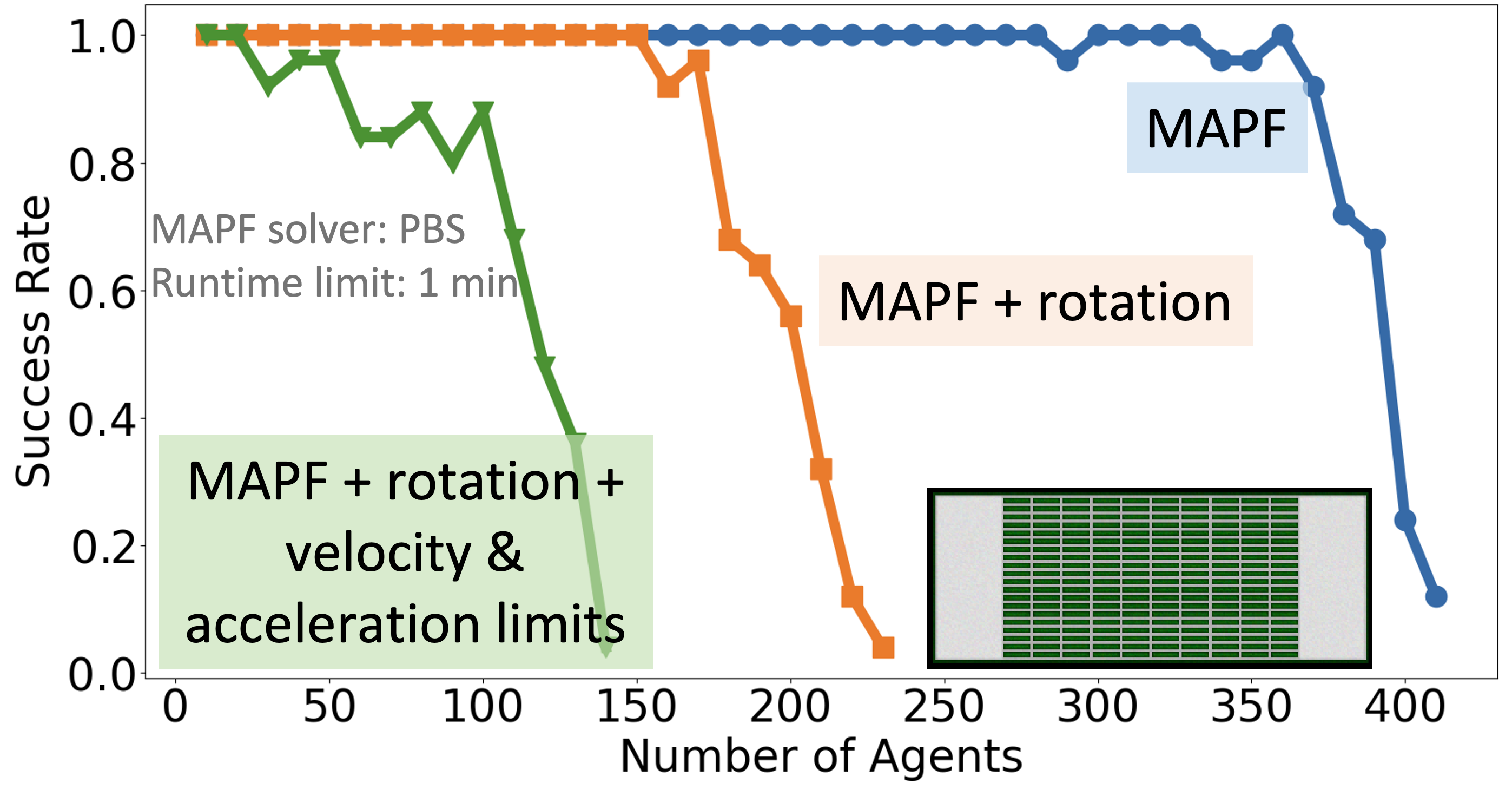
Due to incomplete knowledge of the world and the dynamics of robot interactions, creating perfect MAPF models is impractical. Moreover, building more accurate MAPF models will significantly reduce the scalability of the planner, as evidenced by the figure on the right.
Therefore, our philosophy is to model only critical components of the robot dynamics during MAPF planning and use clever coordination and control strategies during execution to address exact robot dynamics and uncertainty. This is achieved through the use of Temporal Plan Graphs (TPGs). Given a MAPF plan, a TPG allows arbitrary modification of robot speeds as long as the order of visits to locations by different robots remains unchanged. Hence,we can implement a distributed execution policy: Each robot controls its own speed and can move to its next location only if all preceding robots have already visited it. This approach ensures robustness to imperfect MAPF models and accommodates various unexpected events, such as deviations in robot speeds due to actuator errors and breakdowns.
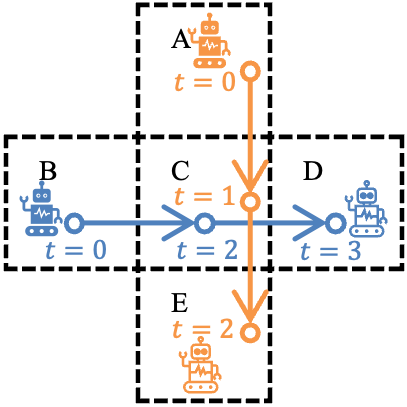
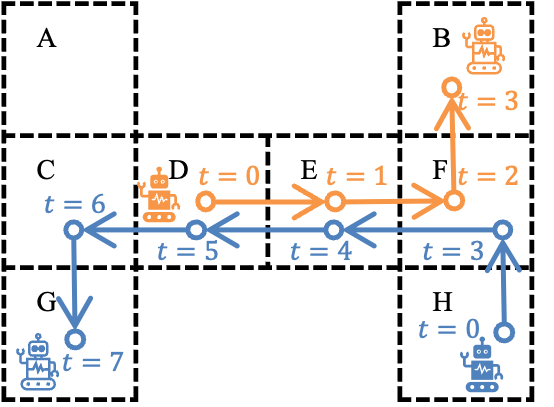

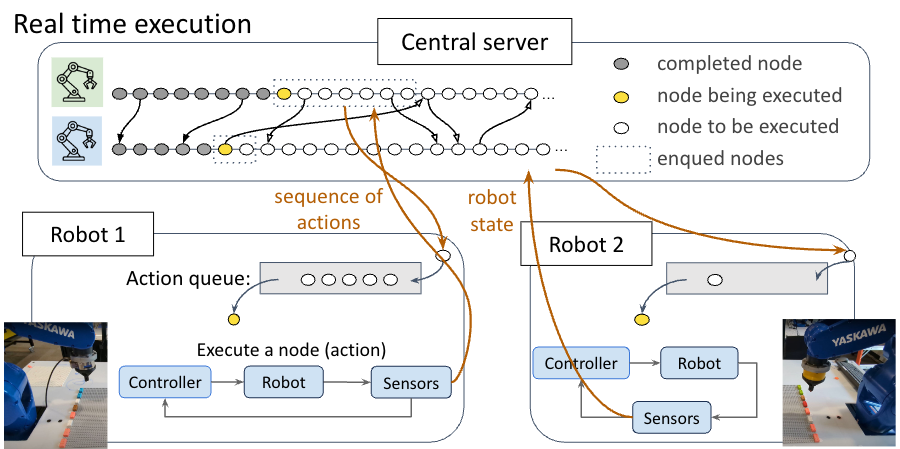
A TPG has two important properties:
- Its execution ensures collision-free movement if passing orders are specified at all potential colliding locations; and
- its execution ensures deadlock-free movement if the TPG graph is cycle-free.
Consequently, constructing and optimizing TPGs can be effectively abstracted as some graph problems. For example, we can dynamically re-optimize the passing order at every location based on the current robot progress by searching for acyclic TPGs that lead to better execution time. We can also preprocesses the TPG graph by identifying noncritical passing orders, whose modification will not lead to deadlocks. Moreover, this execution framework can be applied to various robotic systems, such as mobile robots as well as robotic arms.
Relevant publications
Advancing MAPF towards the Real World: A Scalable Multi-Agent Realistic Testbed (SMART).
Abstract BibTeX arXiv Code Demo VideoWe present Scalable Multi-Agent Realistic Testbed (SMART), a realistic and efficient software tool for evaluating Multi-Agent Path Finding (MAPF) algorithms. MAPF focuses on planning collision-free paths for a group of agents. While state-of-the-art MAPF algorithms can plan paths for hundreds of robots in seconds, they often rely on simplified robot models, making their real-world performance unclear. Researchers typically lack access to hundreds of physical robots in laboratory settings to evaluate the algorithms. Meanwhile, industrial professionals who lack expertise in MAPF require an easy-to-use simulator to efficiently test and understand the performance of MAPF algorithms in their specific settings. SMART fills this gap with several advantages: (1) SMART uses a physics-engine-based simulator to create realistic simulation environments, accounting for complex real-world factors such as robot kinodynamics and execution uncertainties, (2) SMART uses an execution monitor framework based on the Action Dependency Graph, facilitating seamless integration with various MAPF algorithms and robot models, and (3) SMART scales to thousands of robots. In addition, we use SMART to explore and demonstrate research questions about the execution of MAPF algorithms in real-world scenarios.
@misc{ Yan25,
author = "Jingtian Yan and Zhifei Li and William Kang and Kevin Zheng and Yulun Zhang and Zhe Chen and Yue Zhang and Daniel Harabor and Stephen F. Smith and Jiaoyang Li",
title = "Advancing MAPF towards the Real World: A Scalable Multi-Agent Realistic Testbed (SMART)",
year = "2025",
eprint = "arXiv:2503.04798",
}Speedup Techniques for Switchable Temporal Plan Graph Optimization. (Oral)
Abstract BibTeX Publisher arXiv CodeMulti-Agent Path Finding (MAPF) focuses on planning collision-free paths for multiple agents. However, during the execution of a MAPF plan, agents may encounter unexpected delays, which can lead to inefficiencies, deadlocks, or even collisions. To address these issues, the Switchable Temporal Plan Graph provides a framework for finding an acyclic Temporal Plan Graph with the minimum execution cost under delays, ensuring deadlock- and collision-free execution. Unfortunately, existing optimal algorithms, such as Mixed Integer Linear Programming and Graph-Based Switchable Edge Search (GSES), are often too slow for practical use. This paper introduces Improved GSES, which significantly accelerates GSES through four speedup techniques: stronger admissible heuristics, edge grouping, prioritized branching, and incremental implementation. Experiments conducted on four different map types with varying numbers of agents demonstrate that Improved GSES consistently achieves over twice the success rate of GSES and delivers up to a 30-fold speedup on instances where both methods successfully find solutions.
@inproceedings{ JiangAAAI25,
author = "He Jiang and Muhan Lin and Jiaoyang Li",
title = "Speedup Techniques for Switchable Temporal Plan Graph Optimization",
booktitle = "Proceedings of the AAAI Conference on Artificial Intelligence (AAAI)",
pages = "23212-23221",
year = "2025",
doi = "10.1609/aaai.v39i22.34487",
}APEX-MR: Multi-Robot Asynchronous Planning and Execution for Cooperative Assembly.
Abstract BibTeX arXiv TalkCompared to a single-robot workstation, a multi-robot system offers several advantages: 1) it expands the system’s workspace, 2) improves task efficiency, and, more importantly, 3) enables robots to achieve significantly more complex and dexterous tasks, such as cooperative assembly. However, coordinating the tasks and motions of multiple robots is challenging due to issues, e.g., system uncertainty, task efficiency, algorithm scalability, and safety concerns. To address these challenges, this paper studies multi-robot coordination and proposes APEX-MR, an asynchronous planning and execution framework designed to safely and efficiently coordinate multiple robots to achieve cooperative assembly, e.g., LEGO assembly. In particular, APEX-MR provides a systematic approach to post-process multi-robot tasks and motion plans to enable robust asynchronous execution under uncertainty. Experimental results demonstrate that APEX-MR can significantly speed up the execution time of many long-horizon LEGO assembly tasks by 48% compared to sequential planning and 36% compared to synchronous planning on average. To further demonstrate performance, we deploy APEX-MR in a dual-arm system to perform physical LEGO assembly. To our knowledge, this is the first robotic system capable of performing customized LEGO assembly using commercial LEGO bricks. The experimental results demonstrate that the dual-arm system, with APEX-MR, can safely coordinate robot motions, efficiently collaborate, and construct complex LEGO structures.
@inproceedings{ HuangRSS25,
author = "Philip Huang and Ruixuan Liu and Shobhit Aggarwal and Changliu Liu and Jiaoyang Li",
title = "APEX-MR: Multi-Robot Asynchronous Planning and Execution for Cooperative Assembly",
booktitle = "Proceedings of the Robotics: Science and Systems (RSS)",
pages = "",
year = "2025",
doi = "",
}Bidirectional Temporal Plan Graph: Enabling Switchable Passing Orders for More Efficient Multi-Agent Path Finding Plan Execution.
BibTeX Publisher arXiv Code Talk@inproceedings{ SuAAAI24,
author = "Yifan Su and Rishi Veerapaneni and Jiaoyang Li",
title = "Bidirectional Temporal Plan Graph: Enabling Switchable Passing Orders for More Efficient Multi-Agent Path Finding Plan Execution",
booktitle = "Proceedings of the AAAI Conference on Artificial Intelligence (AAAI)",
pages = "17559-17566",
year = "2024",
doi = "10.1609/aaai.v38i16.29706",
}A Real-Time Rescheduling Algorithm for Multi-robot Plan Execution.
BibTeX Publisher arXiv Code@inproceedings{ FengICAPS24,
author = "Ying Feng and Adittyo Paul and Zhe Chen and Jiaoyang Li",
title = "A Real-Time Rescheduling Algorithm for Multi-robot Plan Execution",
booktitle = "Proceedings of the International Conference on Automated Planning and Scheduling (ICAPS)",
pages = "201-209",
year = "2024",
doi = "10.1609/icaps.v34i1.31477",
}
